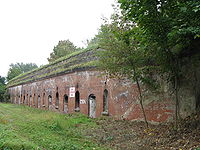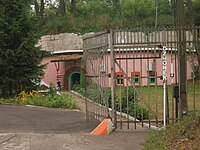Toruń Fortress
The fortress complex – a chain of forts surrounding the city, as well as numerous smaller fortifications supplementing it – was intended to defend the eastern border of Prussia (with the Russian Empire).
Despite much planning and investment,[1] the fortress did not play a significant role in the First World War nor in any later conflict.
[2] During the German occupation of Poland in the Second World War, Germany established and operated a prison for Poles[3] and the Stalag XX-A prisoner-of-war camp[4] for Polish, British, French, Australian and Soviet POWs in the fortress.
Continuing changes in artillery and siege techniques, especially the introduction of an anti-building shell in 1883, rendered some of the plans for the fortress obsolete even before it was finished.
The Toruń Fortress complex would be constantly modernised by the Prussian government, for the last time in 1914 – just before the start of the First World War.
[3] In the overcrowded prison, the Germans interrogated the Poles, who were then either deported to concentration camps or murdered in large massacres carried out in nearby forests.
[5] In the seven southern forts (XI-XVII), the Germans operated the Stalag XX-A prisoner-of-war camp for Polish, British, French, Australian and Soviet POWs.










